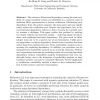132
click to vote
CC
2011
Springer
14 years 4 months ago
2011
Springer
Abstract. We present a disjoint reachability analysis for Java. Our analysis computes extended points-to graphs annotated with reachability states. Each heap annotated with a set o...
ICTAC
2009
Springer
14 years 10 months ago
2009
Springer
The GSPeeDI tool implements a decision procedure for the reachability analysis of GSPDIs, planar hybrid systems whose dynamics is given by differential inclusions, and that are not...
114
click to vote
DEDS
2002
15 years 13 days ago
2002
We propose an approach that integrates and extends known techniques from different areas to handle and analyze a complex and large system described as a network of synchronized com...
105
Voted
FUIN
2007
15 years 17 days ago
2007
Reachability analysis for timed automata using SAT-based methods was considered in many papers, occurring to be a very efficient model checking technique. In this paper we show ho...
FUIN
2008
15 years 21 days ago
2008
Reachability analysis is one of the most successful methods used in design and validation of protocols for classical communication, whereas the predicate/transition-net formalism i...
AAAI
2010
15 years 2 months ago
2010
Dominance testing, the problem of determining whether an outcome is preferred over another, is of fundamental importance in many applications. Hence, there is a need for algorithm...
118
click to vote
AMAST
2008
Springer
15 years 2 months ago
2008
Springer
Term Rewriting Systems (TRSs) are now commonly used as a modeling language for applications. In those rewriting based models, reachability analysis, i.e. proving or disproving that...
101
click to vote
ESEC
1995
Springer
15 years 4 months ago
1995
Springer
This paper presents the results of an exploratory experiment investigating the use of program metrics to predict reachability graph size, reachability graph generation time, and d...
89
Voted
TACAS
2000
Springer
15 years 4 months ago
2000
Springer
We present three methods for the integration of symmetries into reachability analysis. Two of them lead to perfect reduction but their runtime depends on the symmetry structure. Th...
CAV
2004
Springer
15 years 4 months ago
2004
Springer
Abstract. The existence of functional dependency among the state variables of a state transition system was identified as a common cause of inefficient BDD representation in formal...






